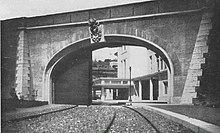Vatican Railway
The main rail tracks are standard gauge and 300 metres (980 ft) long, with two freight sidings, making it the shortest national railway system in the world.[1] Access to the Italian rail network is over a viaduct to Roma San Pietro railway station, and is guaranteed by the Lateran Treaty dating from 1929.[4] Gregory XVI's successor, Pope Pius IX, began the construction of a rail line from Bologna to Ancona but the territory was seized by the armies of the Kingdom of Sardinia in 1860 before it was completed.[5] The utility of rail travel for the mass pilgrimages of the 19th century, beginning with those at Lourdes circa 1858, was one factor that softened opposition to such technology within the Roman Curia.[15] On 18 April 2013, the Turin Group of Train Friends (Gruppo Amici del Treno Torino) departed on a rail tour from Roma Ostiense railway station to arrive into Vatican City station using two ALn 776 rail cars belonging to Seatrain, which also performed a shunt into the tunnel, then departed with three goods wagons.[24] On 24 January 2002 Pope John Paul II and other religious leaders departed the station on board a seven-carriage train to pray at Assisi.The regular service has operated every Saturday since 12 September 2015, with visitors to the Vatican Museums boarding a train to travel to the Pontifical Villas in Castel Gandolfo.[26] Scheduled trains use contemporary suburban rolling stock to travel from Vatican City railway station to Albano Laziale, via Castel Gandolfo.[27][28] Pope Pius XI's planned papal train was never constructed, and the Vatican City State has never employed any railway workers or registered any rolling stock.[30] Pius IX's official train from the time of the Papal States remains on display at the Museum of Rome, housed in the Palazzo Braschi.

Holy SeeVatican CityRoma San PietroFerrovie dello StatoTrack gaugestandard gaugeElectrificationheadshuntCittà del VaticanoVia AureliaRoma OstienseRoma TerminiItalianrail tracksfreight sidingsrailway systemItalian rail networkRoma San Pietro railway stationLateran TreatyPope Pius XICastel GandolfoPope Gregory XVIPapal StatesPope Pius IXBolognaAnconaKingdom of SardiniapilgrimagesLourdesRoman CuriaItalian rail linesearthworkssea levelGovernor's Palace, Vaticanlocomotivebombing of Rome in World War IIGermanPope John XXIIILoretoAssisiSecond Vatican CouncilEurovision NetworkPope Pius XPope John Paul IICaritasPope Benedict XVIRoma Ostiense railway stationALn 776FS Class 625Pope FrancisVatican MuseumsItalian railwayrailway stationGiuseppe MomomarbleH. V. MortonBarclay Bankviaductfascestracksfreight wagonsVatican GardensSt. Peter's BasilicaDomus Sanctae MarthaeLeonine WallPontifical Villas in Castel Gandolfocontemporary suburban rolling stock Roma San PietroVatican City Staterolling stockNew Holland AgricultureMuseum of RomePalazzo BraschiTransport in Vatican CityIndex of Vatican City-related articlesWayback MachineThe Railway MagazineFarmers WeeklyHoly See Press OfficearticlesOutlinePropertiesFrancisList of sovereignsVicar General for Vatican CityHistory of the papacyPrisoner in the VaticanCircus of NeroOld St. Peter's BasilicaPapal tombsLeonine CityCortile del BelvedereSanto Stefano degli UngheresiBorgo NuovoBorgo VecchioPiazza ScossacavalliGeographyMajor basilicaChair of Saint PeterSt. Peter's BaldachinPietàVatican NecropolisSaint Peter's tombTomb of the JuliiVatican GrottoesMonument to the Royal StuartsApostolic PalaceRedemptoris Mater ChapelBorgia ApartmentsClementine HallPapal apartmentsStufetta del cardinal BibbienaCappella PaolinaRaphael RoomsNiccoline ChapelSala RegiaScala RegiaSistine ChapelaltarpiececeilingRoom of TearsHistoricalPaintingsModern and Contemporary ArtPio CristianoEthnographic